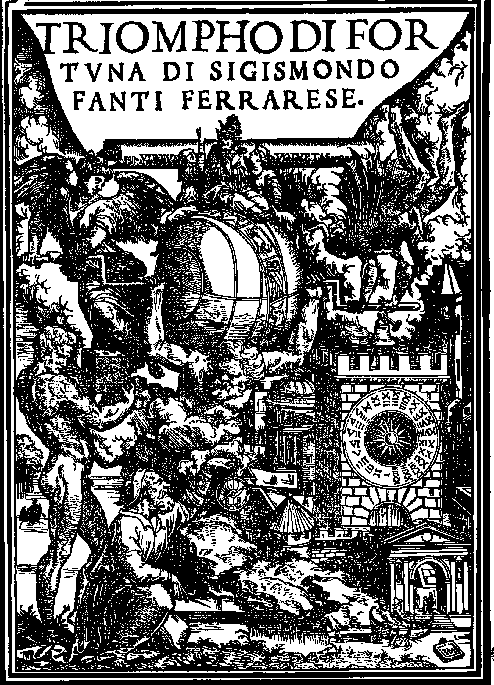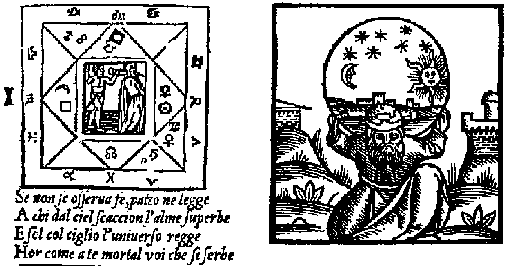|
English |
THE POWER OF THE IMAGE IN ASTROLOGY*
Grazia Mirti mirti@mbox.venco.it |
|
 "With his sight, man contemplates the harmony around him, to then realise it in his soul" Plato, Timaeus, 47d According to Marsilius Ficino the 5 senses are the channels through which man, the Microcosm, is connected to the world, the Macrocosm. In Ernst Gombrich's History of Art (1) it is clearly stated that what ones thinks of an image depends on what one thinks of reality. In antiquity, in Medieval and Renaissance times up to the Baroque, in the Aristotelian tradition images were considered as descriptive, while in Platonic and Neo-platonic culture they were considered revelatory, or even magical. Reality could be imitated by an image or a thought could be visibly expressed. It could precisely describe an event in all its detail, represent a concept or idea, and even illustrate a motto, making an exhortation or advice more convincing and effective. Others have thought that the image not only describes but expresses something more? this happens when, after having seen an image, we reflect on it, meditate on it and contemplate it ourselves. For this reason images are strong, powerful and magical (2). Astrology thrives on symbolic images, images born out of and derived from thousands of years of decoding the stars, of lives spent contemplating the heavens ? we can all bring to mind images of beautiful zodiacs from all epochs, sculptured or painted, noble, refined, simple, illuminated, sophisticated or not, representations of the heavens and the infinite treasures they contain. Marsilius Ficino, in a letter to Lorenzo de'Medici the Younger, writes: "Celestial bodies are not to be sought outside ourselves: the heavens, in fact, are within us, and we have within us the vigour of Fire, the celestial origins"(3) When we observe our beloved stellar images we rediscover within ourselves treasures that have been hidden away for centuries and millenniums. We c onnect to archetypes, we live in symbiosis with the strength of these images, that makes up our world of researchers, colouring and illuminating it, through the solace of a strength that surpasses the centuries and millenniums. Each one of us filters these images through our own cultural and astrological inheritance, attributing many meanings to them, sometimes one differing from the other. A particularly effective example can be seen in an astrological game called the Triumph of Fortune (4) played in the Italian Courts of the 16th century. The original edition can be found, as can most astrological treasures, in the Vatican City library (5). It contains a global synthesis of astrological knowledge, the like of which I have never previously seen. The author, Sigismondo Fanti, originally from Ferrara, dedicated time, talent and thought to this work, devising and designing it himself. Not many know of it and examining it together would constitute a communing astrological rite, capable of expressing the universal fascination and strength of images in Astrology. This international meeting is a moment in which images go beyond words and speak a language that everyone can understand, without translations or comments! The Triumph of Fortune is part of a graphic literary genre to which the so called 'Fortune' and 'Venture' books belong. The Triumph of Fortune was printed in 1527 in Venice, and stands out among other similar works (Libro della Ventura [the Venture Book] by Lorenzo Spirito, 1482, and Le ingeniose Sorti [The Ingenious Fortunes] by Francesco Marcolini of Forli, 1557), in that it has quite specific characteristics. Few copies of it are known as the Church banned it and so they were destroyed. The language used by Sigismondo is very complex and requires decoding by an expert palaeographer. This work, carried out on it by the Italian, Francesco Ciconte, (who I personally engaged for the task) was undertaken with the aim of better understanding the spirit of this astrological work in all its entirety. At the beginning we find a dedication to Pope Clement VII, the illegitimate son of Giuliano de'Medici, born in 1477. He was nominated cardinal in 1513, later tied to Bologna, and became Pope in 1523. There were a number of important events during his Pontificate: the sacking of Rome, the break away from the Catholic Church by Henry VIII, the marriage of Catherine de'Medici to the son of Francis I in Marseillies. The Triumph of fortune was dedicated to him just 7 years before his death. After the usual compliments the author writes to the Pope: "I, Sigismondo Fante, ever faithful lover of the doctrines of the Quadrivium (the highest level of university studies, which also included Astrology), and unworthy mathematician, ?do not restrain myself from consulting the entire body of the mathematical sciences and infinite authors, both modern and ancient: man is in fact guided by the 12 Fortunes of the world, associated with the 12 different winds and even guided by the 12 families of beautiful and victorious Italy, by the terrestrial, aquatic and airborne animals, by the 4 elements, together with all the images of the firmament and our wandering stars; also two great luminaries guide him, the Moon and the Sun. All the world's famous men up to now are grouped altogether in the sentences of 72 astrologers or sybils". The author conceived and realised his masterpiece with the aim of being able to interrupt his exile and return to his natal city, Ferrara, but unfortunately was unsuccessful in this. Each one of the plates is carefully decorated with historical subjects, famous people, wars and events, as in an encyclopaedia or popular almanac, and offers us a synthesis of all then known astrology, from antiquity to the 16th century. There were two different ways of playing the Triumph of Fortune, either by using a clock or dice. The first move consisted of choosing one of the 72 questions proposed by the game. Here lies the subtle difference between this game and others similar. Sigismondo Fanti proposed not only futile and personal questions, but also more general interest and sometimes philosophical questions. Here are a few examples: 1. When should one start a war? 2. Can a fortress be conquered? 3. Can faith be interrupted? 4. Who will win the duel? 5. Is the horse a good buy? 6. Should one change master? 7. Will the servant be grateful to his master? 8. Will the servant rebel? 9. Where will the war take place? 17. Whether one wishes to be loved by the beloved ? 19. Whether the lover should suffer for the beloved 20. Whether there will be famine or plenty this year 21. How many women will a man keep company with 22. What is the meaning of a certain eclipse or the appearance of a comet 23. Whether it is the case to take a beautiful or quite ugly woman 25. How many husbands with a woman have 26. Whether a man will have children 33. Whether the woman is pregnant or not As you can see, the questions can be of personal interest or general. Each question indicates which of the 12 Fortunes one needs to go to and to which letter one needs to refer. Once the Fortune has been found one follows the instructions and goes to the corresponding noble family. As the author notes, the Family has already been chosen on the basis of the question asked, and takes into account the history of the latest generations. If the question concerns love affairs, the family chosen would be the one about which there is much gossip and amorous goings-on ? such as with today's Princes of Monaco or the British Royal family. Nothing is left to chance. In general it refers to the best known Italian families of the time: Aragona, Colonna, Gonzaga, Este, Bentivoglio, Gritti. At this point one decides whether to continue the game by throwing the dice or using the time in which the question was asked. In this case we have a clear application of Horary Astrology. As can be seen in the upper part of the picture, the circle is surrounded by dice, and in the lower part by 21 hours. The hours between 21 and 24 are repeated in nos. 1,2,3, according to the indications given by the author, who perhaps had some difficulty in graphically placing the 24 sections of the circle inside the drawing, and above all in inserting the writing into them. The Wheel one needs to refer to is indicated by the family asked, then followed by the use of the dice or time. The Wheel contains Animals, the Deadly Sins, the Arts (Grammar, Rhetoric, Dialectics, Arithmetic, Music, Geometry, Astrology), the Theological Virtues, Heaven and Fortune. The next passage takes into consideration the Celestial Spheres, including the traditional planets: Saturn, Jupiter, Mars, Sun, Venus, Mercury and the Moon. The 12 zodiac signs and some constellations follow - Ursa Major, Bootes, Hercules, Cassiopeia, Andromeda, Perseus, Serpens, Auriga, Eridanus, Argo Navis and Centaurus - and finally, the 4 elements: Air, Water, Earth and Fire, which are rare found represented graphically. Following the course indicated by going from one stage to another one arrives at the answer, which is shown in the Atlas of the Astrologer Prince, a collection a 72 decorated plates, each one containing 11 zodiac drawings in boxes with a number of answers in verses of rhymed couplets.
It is interesting to note the names of some of the astrologers cited: |
